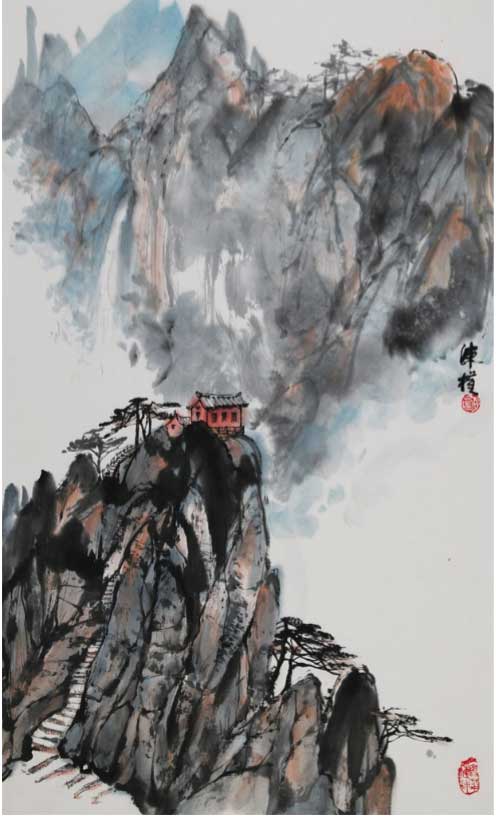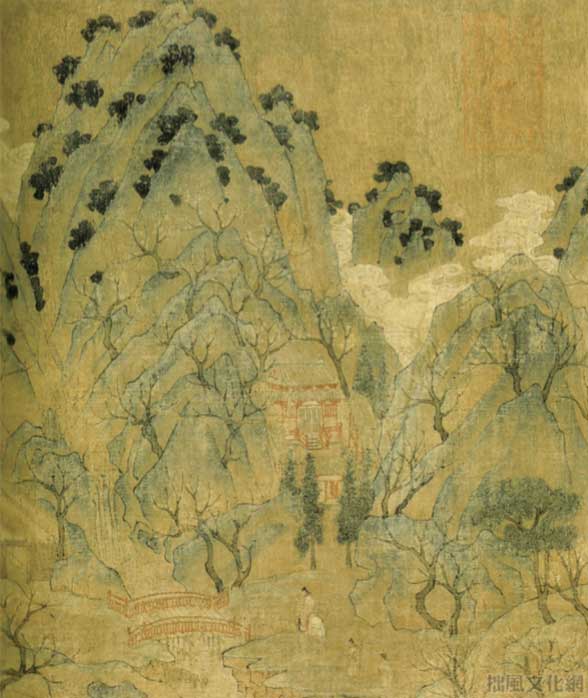Brief History of Chinese Paintings
Figure paintings, landscape paintings, and flower-bird paintings are the three traditional categories of Chinese painting. Chinese painters primarily used landscapes as backgrounds for their figure paintings up to the 5th century. Landscape features including mountains, rocks, trees, and lakes were poorly designed, disproportionately large, and lacking in delineation techniques.
Beginning in the early Sui Dynasty and continuing until the Tang Dynasty (about A.D. 589–906), Chinese artists began painting landscapes without the inclusion of any human figures. Their methods were straightforward. Strongly contrasting hues like greens, blues, and sienna were used to fill in the shape of prominent landscape components including mountains, rocks, clouds, rivers, and boats. Over time, proportions were represented more correctly and objects were layered in contrast, yet different strokes were utilised to imply texture. It was around this time when blue-green landscapes began to appear.
Between the Five Dynasties era and the Sung Dynasty (A.D. 907–1279), landscapes continued to radically change into two main styles: blue-green landscapes and water-ink landscapes. Gold outlines were added to the early blue-green landscapes, which over time evolved into a loose painting technique that focused on ink ornamentation and depiction.
Chinese landscapes began to include significant elements of water-ink landscape. These paintings in the Simple spontaneous style made extensive use of inks and vibrant brushstrokes. In Japan they are known as Sumi-e, and Shui-mo hua in China.

Yellow Mountain
Ink & Color on raw Shuan Paper
22” x 16” (56cm x41cm)
Spontaneous-Style Painting
This style of Chinese art, also known as Scholar Style, was popularised during the Sung era and is still prevalent today. Its distinctive features include the delicate application of ink and expressive brushwork to depict the textures of mountains, rocks, water, clouds, and other natural elements. In a freestyle painting, ink representations take precedence over colour.
An Early example of blue-green style chinese landscape painted by Zhan Ziqian featuring mountains and trees thinly outlined with ink & filled in with vivid greens, blues and browns.


Pre-fifth century chinese painting
This long painting scroll by Gui Kaizhi, painted around the year 380, is an example of early Chinese art with wonderfully portrayed figures and modest, unstylized trees and hills.
Art from Yuan Dynasty (a.d.1279-1368) to Ming Dynasty (a.d.1368-1644)
Throughout feudal China, the scholarly painter’s purpose was to capture the spirit and reality of nature. Literati Paintings were popular during this time period. Ink and intricate brushwork were employed to enhance images in order to capture the spirit and beauty of nature. Skilled landscapes demonstrated a harmony between humans and environment, not just impressions of it: art as poetry. Chinese landscapes progressed in this manner, with the purpose of mastering the spiritual and personal aspects of art rather than strict interpretation of formal technique. Artists began inscribing poems into their landscapes during the Ming era to communicate personal thoughts and ideologies.
Ch’ing Dynasty (a.d.1644-1912)
Landscape painting became increasingly influenced by the copying of previous painters during the Ch’ing dynasty. Painting criticism turned away from nature and personal spiritual fulfilment and toward technique. However, as the twentieth century progressed, western techniques began to influence Chinese painters, and a new hybrid style emerged. Zhang Daqian is a well-known Chinese artist recognised for his splash-ink pouring style, which is said to be derived from the popular abstract expressionist movement in the United States.
1900s through 1950s
From the early 1900s until the 1950s, a group of Cantonese painters from Guandong Province, which borders Hong Kong, created a new movement that combined traditional Chinese painting with Japanese and Western painting approaches. Their purpose was to move Chinese painting history away from feudalism and into modern society. They not only mastered traditional theories and techniques, but they also sketched outside to examine their surroundings firsthand, resulting in more natural colours and correct proportions and perspectives. They also employed non-traditional Shuan Paper to suit their painting techniques. This new Chinese painting school is known as the Lignin School of Painting, and it is currently popular in Southern China, Hong Kong, Taiwan, and other parts of the world. In regard to Guangdong Province, Ling Nan literally translates to “southern side of the mountains.”
4 Fundamental Chinese Painting Techniques
You can generate stunning colour and ink variation in your landscape by using four classic Chinese painting techniques: Wet on dry, wet into wet, ink breaking, and ink pouring.


